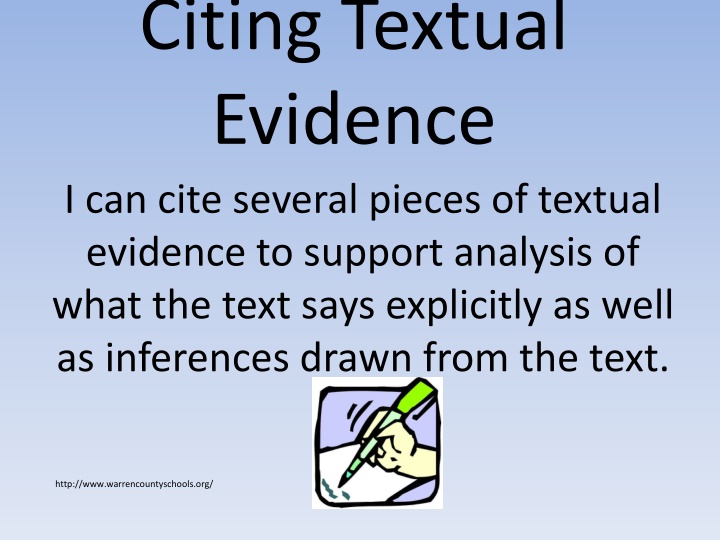
Importance of Citing Textual Evidence in Analysis
Learn how explicit textual evidence supports analysis and inferences drawn from a text, why it is essential, and how to cite it effectively. Discover the significance of using direct evidence from the text to validate opinions and ideas, plus key tips on citing explicit textual evidence for academic and real-world contexts.
Download Presentation

Please find below an Image/Link to download the presentation.
The content on the website is provided AS IS for your information and personal use only. It may not be sold, licensed, or shared on other websites without obtaining consent from the author. If you encounter any issues during the download, it is possible that the publisher has removed the file from their server.
You are allowed to download the files provided on this website for personal or commercial use, subject to the condition that they are used lawfully. All files are the property of their respective owners.
The content on the website is provided AS IS for your information and personal use only. It may not be sold, licensed, or shared on other websites without obtaining consent from the author.
E N D
Presentation Transcript
Citing Textual Evidence I can cite several pieces of textual evidence to support analysis of what the text says explicitly as well as inferences drawn from the text. http://www.warrencountyschools.org/
Explicit Textual Evidence When we have ideas about what we read, we need to cite explicit textual evidence to support our ideas. When we read, we are often asked to express our ideas about the text. In order to let people know we aren t making things up, we should use explicit textual evidence to support our opinions or answers. In the real world, people who can back up an opinion with explicit textual evidence are taken more seriously than people who can only give a reason of just because
What is Explicit Textual Evidence? The name really says it all 1. Explicit: direct 2. Textual: from the text 3. Evidence: support for your answer, opinion or idea So, explicit textual evidence is finding support for your answer, opinion or idea that comes directly from the text
How do we Cite Explicit Textual Evidence? It s as easy as 1, 2, 3 1. State your idea: State your idea about the text. If you are answering a specific question, be sure to restate the question. 2. Cite from the text: Give specific evidence from the text by paraphrasing or directly quoting from the text. Possible sentence starters are In the first paragraph , ____the author says, The text states , The text describes , For example , For instance 3. Explain the evidence:Explain how the quote(s) or paraphrase(s) support your idea. Possible sentence starters are This shows , This means , This reveals , This highlights the difference between
For Example Cats kill between 1.4 billion and 3.7 billion birds every year in the United States alone, a new report concludes. That s nearly a billion more birds at least than estimated by some previous studies, Peter Marra told Science News . This research scientist, who works at the Smithsonian Conservation Biology Institute in Washington, D.C., led the new study. Any long-term solution will be controversial. Some people propose catching wild cats and neutering them, which means performing minor surgery to make them unable to reproduce. That won t make them kill fewer animals. But it will slow the increase in number of these natural-born killers. Other people have proposed catching and killing feral cats. What was the author s purpose in writing this text?
What was the authors purpose in writing this text? The author s purpose was to make people aware that cats killing birds has become a problem and that any solution to the problem will be controversial. In the first paragraph, the author points out that, Cats kill between 1.4 billion and 3.7 billion every year. The author s use of that statistic really catches a reader s eye because they are such big numbers. This shows just how big the problem is. Then, in the second paragraph, the author says that there are two controversial ways to solve the problem, by either catching wild cats and performing surgery on them so they can t reproduce or catching and killing them. The author was demonstrating that the possible solutions are controversial because most people probably would not like the idea of cats being caught in order to either operate on them or kill them. Here, the writer answers the question with an idea about the text. Here, the writer includes a direct quote from the text as evidence. The writer comments on how the quoted text that was cited as evidence helped form the idea that was stated to answer the question. Here, the writer paraphrases from the text to give a 2nd piece of evidence. Here, the writer comments on how the paraphrased text helped form the idea that was stated to answer the question.
Your Turn! Question: How does the author try to help you understand the term tensile strength ? Answer the question using the steps of citing textual evidence: state your idea, cite what in the text led you to that idea, and explain the evidence. Big marine predators that try to snack on a hagfish get a nasty surprise. When threatened, the slender hagfish releases enough snotty goo to gag a shark. Materials scientists from Douglas Fudge s laboratory at the University of Guelph in Canada have now found a way to create strong, stretchy fibers from the slime. Hagfish slime contains tiny fibers that give it strength and help keep it from tearing apart. (Those fibers also help gag any shark or other hungry predator.) The fibers are made of proteins similar to those found in fingernails and hair. (Proteins are often called the building blocks of life. ) The Canadian scientists used the slime proteins to create threads about as long as an unsharpened No. 2 pencil, but much skinnier. Hagfish threads have remarkable tensile strength: That means they can stretch a long way before breaking almost as far as spider silk can, explains Fudge. What s more, he notes, fabrics from hagfish threads would be more environmentally friendly than many modern materials, like nylon (which comes from petroleum).
